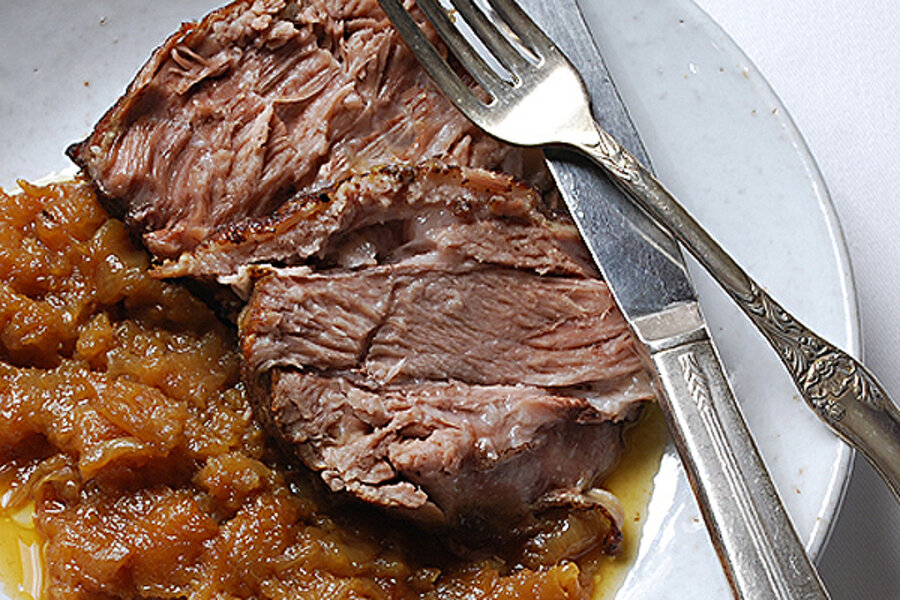Makes 4 to 6 servings
Adapted from a Gourmet magazine recipe
1 4-pound bone-in Boston butt pork roast
1 to 1-1/2 teaspoons Chinese five-spice powder
2 garlic cloves, cut into slivers (about 6 per clove)
Salt and freshly ground black pepper, to taste
2 tablespoons olive oil
4 medium yellow onions, roughly chopped
3 medium apples, peeled, cored and roughly chopped (see Kitchen Notes)
3/4 cup unfiltered apple cider (see Kitchen Notes)
1. Score fat and any skin on pork in a crosshatch pattern. Sprinkle five-spice powder liberally over all sides of the roast (I used a small strainer, tapping it with a knife to evenly coat the roast). Rub five-spice powder into the meat. Make slits all over meat with a small sharp knife and insert a garlic sliver in each slit. Place roast in a covered dish or wrap in plastic and marinate for at least 30 minutes and up to 2 hours.
2. Preheat oven to 325 degrees F. Season pork with salt and pepper.
3. Heat a large, heavy nonstick skillet over moderately high heat. Add oil and brown meat on all sides, turning occasionally with the aid of tongs and a carving fork, about 10 minutes (see Kitchen Notes). Transfer pork to a plate.
5. Add onions to pan and sauté over medium heat, stirring occasionally, until softened and starting to turn golden, about 5 minutes. Add apples and 1/2 teaspoon salt and sauté, stirring occasionally, about 10 minutes more.
6. Stir in cider, scraping up any browned bits. Transfer apple/onion mixture to a dutch oven or heavy lidded pot large enough to hold the roast. Add roast and any accumulated juices to the pot.
7. Cover pot with a tight-fitting lid and braise pork in middle of oven until very tender, 2-1/2 to 3 hours. The roast can be prepared 1 day ahead up to this point – see Kitchen Notes for details.
8. Transfer pork to a cutting board with the aid of tongs and carving fork and let rest for about 5 minutes. Transfer apple/onion mixture to a serving dish, using a slotted spoon to strain off excess liquid and rendered fat. By now, the onions and apples will have pretty much fallen apart, taking on the consistency of chunky applesauce. Adjust seasoning, slice pork and serve.
Kitchen Notes
Apples, apple cider. Ideally, you want nice, tart cooking apples. I still had some Russet apples left over from my grilled cheese adventures, so I used those. Granny Smiths would also be good. For the cider, unfiltered is best. It’s the “cloudy” cider, the equivalent of orange juice with lots of pulp. Clear apple cider will work too. In a pinch, you can even use apple juice, but make sure there are no added sugars. The apples and onions will add plenty of sweetness to the compote.
Browning the meat. Usually when you’re braising or roasting something in a dutch oven – or in our case, our beautiful, blue, oval Staub Cocotte – you brown the meat in the pot it will braise in. But not when you’re wrestling with four pounds of meat with a carving fork and tongs. I can’t think of a better recipe for burned wrists than attempting this in the confined space of a hot, high-sided pot. Use a skillet to brown the meat. Trust me.
Make ahead. You can make this dish one day ahead. If you plan to do so, cook it for just 2-1/2 hours the first day. Cool, uncovered, then chill, covered. I did this and was able to skim off some off the solidified fat before reheating it. Reheat roast in its apple/onion mixture, covered, at 325 degrees F. for about 45 minutes.
Read the full post on Stir It Up!








